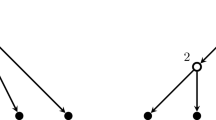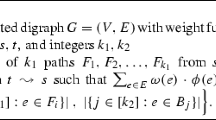Abstract
Given a graph G with a set of terminals, two weight functions c and d defined on the edge set of G, and a bound D, a popular NP-hard problem in designing networks is to find the minimum cost Steiner tree (under function c) in G, to connect all terminals in such a way that its diameter (under function d) is bounded by D. Marathe et al. (J. Algoritm. 28(1), 142–171, 1998) proposed an (O(lnn),O(lnn)) approximation algorithm for this bicriteria problem, where n is the number of terminals. The first factor reflects the approximation ratio on the diameter bound D, and the second factor indicates the cost-approximation ratio. Later, Kapoor and Sarwat (Theory Comput. Syst. 41(4), 779–794, 2007) introduced a parameterized approximation algorithm with performance guarantee of \((O(p \cdot \frac {\ln n}{\ln p}), O(\frac {\ln n}{\ln p}))\) for any input value p>1, by which one can improve the approximation factor for cost at the price of worsening the approximation factor of diameter. In this paper, we consider the reverse scenario in which minimizing the diameter of the solution is more important. We first propose a parameterized approximation algorithm with performance guarantee of \((O(\frac {\ln n}{\ln p}),O(p \cdot H_{p} \cdot \frac {\ln n}{\ln p}))\), where H p = 1+1/2+…+1/p is the p th harmonic number. Parameter p is part of the input and this algorithm runs in polynomial time for constant values of p. We also present another algorithm with approximation ratio of \((O(\frac {\ln n}{\ln p}),O(\mu \cdot p \cdot \frac {\ln n}{\ln p}))\) which relies on the approximation factor (μ) of the NP-hard problem min-degree constrained minimum spanning tree.




Similar content being viewed by others
Notes
In order to do this, we use the definition introduced by Howell [23] as follows. Assume that we have function \(f : \mathbb {N}^{k} \rightarrow \mathbb {R}^{\geq 0}\), and \(\hat {f}(n_{1}, \ldots , n_{k}) = \max \{f(i_{1}, \ldots , i_{k}) | 0\leq i_{j} \leq n_{j}, 1 \leq j \leq k \}\). Now, g(n 1,…,n k ) = O(f(n 1,…,n k )) if and only if there exist constants \(c_{0} \in \mathbb {N}\) and \(c_{1} \in \mathbb {R}^{>0}\) such that for all n 1,…,n k ≥c 0, we have g(n 1,…,n k ) ≤ c 1 f(n 1,…,n k ) and \(\hat {g}(n_{1},{\ldots } ,n_{k}) \leq c_{1} \hat {f}(n_{1},{\ldots } ,n_{k})\).
In the Set Cover Problem we are given a set U of m elements and a set S of n subsets of U where the union of these n subsets is equal to U. The problem asks for a minimum number of subsets whose union becomes U (we say U has been covered). In the weighted version, each subset is assigned a positive weight and the problem asks for the collection of subsets with minimum total weight that covers U.
References
Aggarwal, V., Aneja, Y.P., Nair, K.P.K.: Minimal spanning tree subject to a side constraint. Comput. Oper. Res. 9(4), 287–296 (1982)
Akgün, İ., Tansel, B.Ç.: Min-degree constrained minimum spanning tree problem: New formulation via Miller-Tucker-Zemlin constraints. Comput. Oper. Res. 37(1), 72–82 (2010)
Awerbuch, B., Baratz, A., Peleg, D.: Cost-sensitive analysis of communication protocols. In: Proceedings of the Annual ACM Symposium on Principles of Distributed Computing, pp. 177–187 (1990)
Chvátal, V.: A greedy heuristic for the set-covering problem. Math. Oper. Res. 4(3), 233–235 (1979)
de Almeida, A.M., Martins, P., de Souza, M.C.: md-MST is NP-hard for d≥3. Electron Notes Discrete Math. 36, 9–15 (2010)
de Almeida, A.M., Martins, P., de Souza, M.C.: Min-degree constrained minimum spanning tree problem: Complexity, properties, and formulations. Int. Trans. Oper. Res. 19(3), 323–352 (2012)
Ehrgott, M.: Multicriteria Optimization. Springer, Berlin, Germany (2005)
Ergun, F., Sinha, R., Zhang, L.: An improved FPTAS for restricted shortest path. Inf. Process. Lett. 83(5), 287–291 (2002)
Hajiaghayi, M. T., Kortsarz, G, Salavatipour, M.R.: Approximating buy-at-bulk and shallow-light k-Steiner trees. In: Approximation, Randomization, and Combinatorial Optimization. Algorithms and Techniques, pp. 152–163. Springer Berlin Heidelberg (2006)
Hassin, R.: Approximation schemes for the restricted shortest path problem. Math. Oper. Res. 17(1), 36–42 (1992)
Ho, J.-M., Lee, D.T., Chang, C.H., Wong, C.K.: Bounded diameter minimum spanning tree and related problems. In: Proceedings of the Annual ACM Symposium on Computational Geometry, pp. 276–282 (1989)
Hong, S.-P., Chung, S.-J., Park, B.H.: A fully polynomial bicriteria approximation scheme for the constrained spanning tree problem. Oper. Res. Lett. 32(3), 233–239 (2004)
Howell, R.R.: On asymptotic notation with multiple variables. Technical Report, Kansas State University, Manhattan, KS, USA (2008)
Kapoor, S., Sarwat, M.: Bounded-diameter minimum-cost graph problems. Theory Comput. Syst. 41(4), 779–794 (2007)
Khani, M.R., Salavatipour, M.R.: Improved approximations for buy-at-bulk and shallow-light k-Steiner trees and (k, 2)-subgraph. In: Algorithms and Computation, pp. 20–29. Springer Berlin Heidelberg (2011)
Kompella, V.P., Pasquale, J.C., Polyzos, G.C.: Multicasting for multimedia applications. In: INFOCOM’92. 11th Annual Joint Conference of the IEEE Computer and Communications Societies, pp. 2078–2085. IEEE (1992)
Lorenz, D.H., Raz, D.: A simple efficient approximation scheme for the restricted shortest path problem. Oper. Res. Lett. 28(5), 213–219 (2001)
Marathe, M.V., Ravi, R., Sundaram, R., Ravi, S.S., Rosenkrantz, D.J., Hunt III, H.B.: Bicriteria network design problems. J Algoritm. 28(1), 142–171 (1998)
Martins, P., de Souza, M.C.: VNS and second order heuristics for the min-degree constrained minimum spanning tree problem. Comput. Oper. Res. 36(11), 2969–2982 (2009)
Marx, D.: Parameterized complexity and approximation algorithms. Comput. J. 51(1), 60–78 (2008)
Ravi, R., Goemans, M.X.: The constrained minimum spanning tree problem. In: Algorithm Theory—SWAT’96, pp. 66–75. Springer Berlin Heidelberg (1996)
Warburton, A.: Approximation of Pareto optima in multiple-objective, shortest-path problems. Oper. Res. 35(1), 70–79 (1987)
Zhu, Q., Parsa, M., Dai, W.W.M.: An iterative approach for delay-bounded minimum Steiner tree construction. Technical Report UCSC-CRL-94-39, UC Santa Cruz (1994)
Author information
Authors and Affiliations
Corresponding author
Rights and permissions
About this article
Cite this article
Mashreghi, A., Zarei, A. When Diameter Matters: Parameterized Approximation Algorithms for Bounded Diameter Minimum Steiner Tree Problem. Theory Comput Syst 58, 287–303 (2016). https://doi.org/10.1007/s00224-015-9615-7
Published:
Issue Date:
DOI: https://doi.org/10.1007/s00224-015-9615-7




